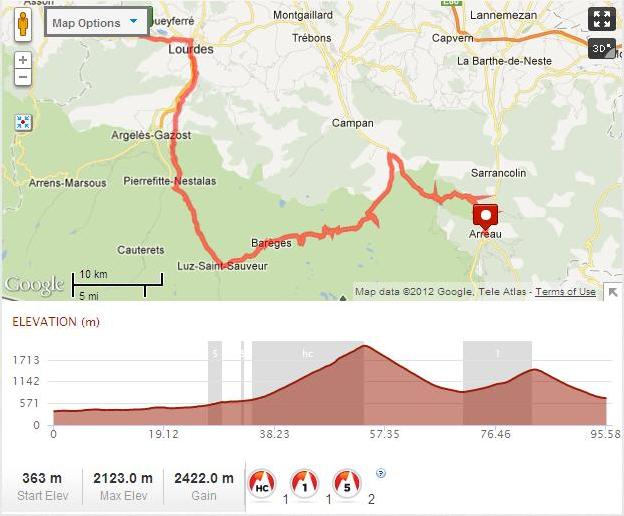Etape 3 – 105km
So this is the biggie!
After a leisurely ride through Lourdes (stop for some Holy Water if you need it) and along the flat valley floor we hit the mighty Col du Tourmalet! Along with l’Alpe d’Huez this is the most famous climb in the Tour de France. The climb is 19km long with an average gradient of 7.4% and was first used in the Tour of 1910 when Octave Lapize was the first man over the top.
Lapize went on to win the Tour in 1913 but he is most remembered for shouting at the Tour Officials as he crossed the summit in 1910 ‘Vous êtes des assassins! Oui, des assassins!' ('You are murderers! Yes, murderers!') The stage that day was 326km in length, featured 7 brutal climbs, and was raced on unsurfaced roads with single-gear bikes!
The Col du Tourmalet is legend in itself and at 2,115m the highest road pass in France.
The Pyrenees were included in the Tour de France at the insistence of Alphonse Steinès, a colleague of the organiser, Henri Desgrange. He told the story in a book published soon after the event.
Steinès first agreed that the Tour would pay 2,000 francs to clear the Col d'Aubisque, then came back to investigate the Tourmalet. He started at Ste-Marie-de-Campan with sausage, ham and cheese at the inn opposite the church and arranged to hire a driver called Dupont from Bagnères-de-Bigorre. Dupont and Steinès made it the first 16km, after which their car came to a stop. Dupont and Steinès started to walk but Dupont turned back after 600m, shouting: "The bears come over from Spain when it snows." Steinès set off. He mistook voices in the darkness for thieves. They were youngsters guarding sheep with their dog. Steinès called to one. "Son, do you know the Tourmalet well? Could you guide me? I'll give you a gold coin. When we get to the other top, I'll give you another one." The boy joined him but then turned back. Steinès rested on a rock. He considered sitting it out until dawn, then realised he'd freeze. He slipped on the icy road, then fell into a stream. He climbed back to the road and again fell in the snow. Exhausted and stumbling, he heard another voice. "Tell me who goes there or I'll shoot." "I'm a lost traveller. I've just come across the Tourmalet." "Oh, it's you, Monsieur Steinès! We were expecting you! We got a phone call at Ste-Marie-de-Campan. Everybody's at Barèges. It's coming on for three o'clock. There are search teams of guides out looking for you." The organising newspaper, l’Auto, had a correspondent at Barèges, a man called Lanne-Camy. He took him for a bath and provided new clothes. Steines sent a telegram to Desgrange: "Crossed Tourmalet stop. Very good road stop. Perfectly feasible."
We stop for lunch on the descent of the Tourmalet before we climb the Col d’Aspin (1489m). The climb is 13km long but only the last 8km are steep at an average of 8%. The climb has been used 71 times in the Tour from 1910 when (yep you’ve guessed it) our man Octave Lapize was the first over the summit. In the 1950 Tour, there was an altercation at the summit, with bottles and stones being thrown at the riders, and the Italian team with Gino Bartali and Fiorenzo Magni, the leaders at the time, withdrew from the Tour at the end of the stage.

